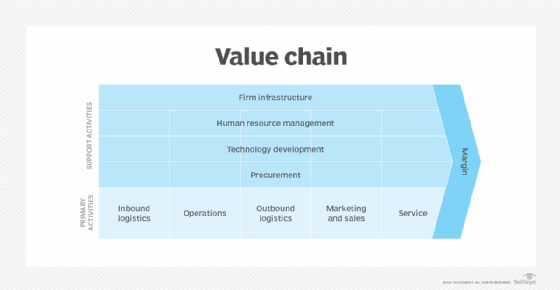Value chain vs. value stream: What are the differences?
Understanding value chains vs. value streams can be difficult, but both approaches can help companies improve their operations and customer service. Learn more.
In today's business environment, companies are always looking for a way to stand out and add value for both the company and the consumer.
Two ways of understanding a company's added value are value chains and value streams. These methods share similar names, but subtle differences exist between the two. Both can help organizations improve their customer service, the company's bottom line and supply chain operations.
Here's what supply chain leaders should know about value chains vs. value streams.
What is a value chain?
A value chain is the series of activities that comprise the lifecycle of a product or service, from inception through production to purchase by the consumer. Value chain analysis examines the productivity of a company's operations.
Supply chain activities that are often part of a value chain include sourcing high-quality parts, aligning product features with consumer needs, rectifying defects during the manufacturing process and fast delivery.

Several other business functions' activities are part of the value chain as well. These include the following:
- Marketing and sales. Value chain activities include understanding consumer pain points and needs and creating marketing materials that convey the features and benefits of products.
- Customer service. Value chain activities include providing information for consumers and establishing return policies that are well-received by customers.
- Procurement and purchasing. Value chain activities include sourcing the right external vendors and suppliers and optimizing the purchase and supply of products.
- HR management. Value chain activities include hiring and retaining staff who will meet business needs.
- Technology. Value chain activities include investing in technologies that will improve business operations and company interactions with consumers.
- Company infrastructure. Value chain activities include optimizing all the support functions in a business, so they are each adding as much value as possible.
What is a value stream?
While a value chain focuses on the big picture of a company's operations, value streams drill down into the details, providing deeper insight into specific business processes. A value stream defines the processes that result in a happy customer.
This article is part of
Guide to supply chain management
Company leaders carry out value stream mapping to better understand specific parts of the value chain. These findings can then help organizations improve aspects of their operations in various ways, such as making processes more efficient, which can then improve customer service.
Value stream mapping is part of the Lean Six Sigma manufacturing approach.
The differences between value chains vs. value streams
The most important difference between value chains and value streams is that value chains focus on business operations as a whole, while value streams focus on specific processes within the company.
Company leaders usually conduct a value chain analysis to better understand high-level operations, while value stream mapping helps leaders understand how to add value and better interact with consumers.







